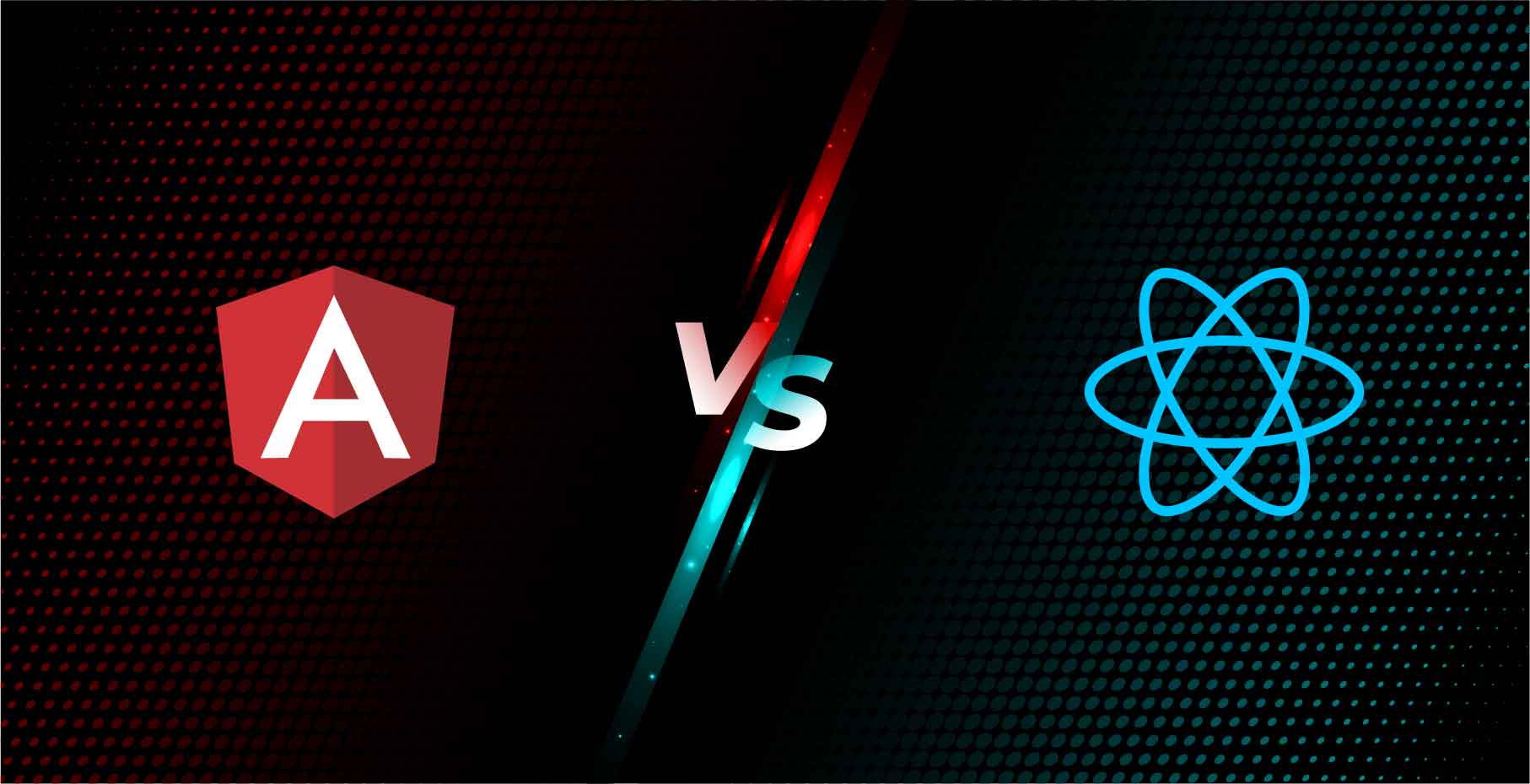Both Angular and React are benign used by developers. In this guide we will discuss why the developers choose what they choose. We will discuss the Angular vs React comparison guide and find what is the optimal technology to use.
This guide on Angular vs React will shed light upon some facts on advantages and disadvantages along with a complete description of features such as test and performance.
At the end of this Angular vs React Guide, you will be able to choose the technology among these two that will fit your requirements.
Definition – Angular vs React
Angular
Angular is an open-source JavaScript framework for mobile and web apps. The Angular developer community and Google’s Angular Team manage this TypeScript-based framework. Angular 2.0 is a complete revamp of AngularJS that was released in 2016. (version 1.0). There are presently six versions of Angular. When it comes to creating dynamic web applications, Angular comes into play. It allows programmers to utilize HTML as a template language. Furthermore, it allows HTML’s syntax to clearly and simply describe the application’s components. The (MVC) programming configuration is also supported.
TypeScript or JavaScript, a superset of JS built specifically for larger projects, may be used by Angular. TypeScript has been discovered to be more compact than JavaScript.
React
React is a JavaScript-based UI development library. It was launched in 2013 and is run by Facebook and an open-source development team. You must utilise React JS for creating interactive user interfaces. Its functioning method makes advantage of server-side rendering to provide customizable performance options. The procedure is made more efficient by using JavaScript ES6+ in conjunction with JSX script.
Advantages – Angular vs React
The following is the Angular vs React comparison of most of the advantages. This list consists of all the pretty things both this Angular vs React technology offers. The list will provide ample knowledge on deciding the best one among these Angular vs React.
Angular
It separates the business logic of the programme from its visual display, resulting in improved performance and fewer defects.
This method produces a significantly faster response time, which is very important for online applications.
Angular Material should be mentioned when it comes to design. It’s a built-in library that helps you design components faster. It includes UI components like buttons, navigation patterns, and indications that have previously been modified to multiple browsers.
Everything in Angular is arranged into modules, which allows for easy code reuse. Modules group together a set of characteristics based on a set of criteria, and they can function alone or as part of a larger system. So that modules may be reused and easily modified in different programmes.
They raise the level of HTML interactivity. All directives in Angular begin with Ng, and HTML recognises them as part of the Angular web application.
Because of TypeScript, these functionalities are available. JavaScript is a lot more versatile, yet it only allows for dynamic type. The applications become more safe and protected as a result of the OOP approach. Static typing may appear to be a waste of time at times, but it finally results in a considerably lower number of defects.
React
The activities are completed faster, and the development and testing time is significantly decreased, thanks to the virtual DOM.
React comes with a number of built-in UI components that developers may reuse many times. Furthermore, there are several versions to suit every browser.
All elements in React are built as distinct components, similar to Angular, so programmers may reuse them in different programmes. It also allows you to change the visual design of specific pieces without affecting the rest of the code.
Disadvantages – Angular vs React
In the following paragraph we discuss the disadvantages between Angular vs React. Keep a note on the points so it becomes easier for you to distinguish between Angular vs React.
Angular
Although TypeScript is a mature and stable language, it does not have the same level of popularity as JavaScript. As a result, it may be challenging to locate experts who can start working with Angular 2.0+ right once. However, if a programmer is familiar with the core OOP ideas, mastering Angular will not be difficult.
In many languages, the command line is a useful tool, but it’s so common in Angular that understanding the CLI commands is required. Despite the fact that Angular’s documentation is rather substantial, there aren’t many instructions on how to utilise the CLI in Angular.
React
As previously stated, the lack of the required OOP approach and static typing can lead to developer errors and, as a result, unexpected and erroneous code modifications. This disadvantage is especially apparent when many professionals are working on the same application. As a result, a novice developer may attempt to alter a variable, which will surely result in an application crash due to dynamic typing.
React is fantastic for generating individual UI components, but it’s useless when it comes to building a whole application with it. If you want to create a full project using React, you’ll need to spend some time hunting for all of the required libraries.
Popularity – Angular vs React
To determine the popularity of both Angular vs React, we will discuss a few elements. Both Angular and React have acquired popularity in the development community and on discussion boards. Angular has 56,586 stars, whereas Reactjs has 142,606 stars, according to the most popular platform’s statistics.
React, on the other hand, is only a library on the opposite of the full-fledged Angular framework. On the other hand, Angular always had a high average number of stars when compared to the library framework Reactjs. React has a larger number of starts because of its early release.
Features – Angular vs React
The following section will talk about features that these Angular vs React offers to developers. With these features, you will be able to judge the best technology that will support your enterprise.
Test – Angular vs React
Using these technologies to make sophisticated software on one hand and overcoming the session of testing to find bugs in the code is another. In this section, we shall see the scenario of testing software between Angular vs React.
Angular
Angular offers a number of characteristics, including separation of the unit of code and was developed with testability in mind. For example, dependency injection, a built-in feature of Angular, makes it simple to pass in component dependencies and to mimic the components.
React
In React, tests are predictable due to the presence of mocking functions. As part of the development process, Reactjs runs test suites in the background to perform test cases. It also includes test runners such as Mocha, Ava, and Jest, which may execute tests while the development process is in progress.
Performance – Angular vs React
Angular
Angular has taken care of everything that optimizes coding techniques and leads to a consistent level of programming that improves speed over time. It’s something developers should think about when comparing the performance of Angular vs React.
Optimizing the digest cycle for your suggested code structure, for example. While you construct a codebase for additional modules, monitoring and optimizing the loop can check the modifications that are previously examined.
React
Reactjs is noted for its component reuse flexibility, for example, starting with the smallest components like checkboxes and buttons, moving the wrapper components, and finally reaching the root components.
Such routines, regardless of project complexity, contribute to consistency in app performance and make code quality and maintenance easier.
Data Binding – Angular vs React
Here, these Angular vs React technologies work in different ways from one another.
Angular
The two-way binding is used by Angular. When you change the state of an interface element (user input) to Angular, for example, the model’s state changes as well. The interface element changes as the model’s state changes, hence the two-way data binding.
React
React, on the other hand, only offers one-way binding. The state of the model is changed first, and then the modification of the interface element is reflected. The state of the model, on the other hand, does not change if the interface element is changed.
When to Choose – Angular vs React
Angular
- – While working with HTML, CSS, JavaScript
- – Need high customization
- – Need several events
- – To create shareable components
React
- – While working with JavaScript, C#
- – Feature rich app
- – High productivity situation
User – Angular Vs React
Angular
- – Microsoft Office
- – Deutsche Bank
- – Mixer
- – Santander
- – Gmail
- – Forbes
- – UpWork
- – PayPal
- – Grasshopper
- – Samsung
React
- – Yahoo!
- – New York Times
- – Netflix
- – Airbnb
- – Discord
- – Dropbox
- – Khan Academy
Jobs – Angular vs React
There are researches and statistics on which among Angular vs React has more downloads which is led by React. As of now, React is more popular than react. But it is also suggested that due to early release, React got more fame than Angular. But it doesn’t mean that Angular developers are in less demand. As you have already seen, some of the popular companies use these technologies.
Every year, there are almost 250,000 job ads for Angular and 390,000 for React ads.
According to these facts, we can sum up that developers are going for React. But it is also advisable to test other technologies as well.
Conclusion
When deciding the best between Angular vs React, experts consider the project’s characteristics. Both systems offer advantages and disadvantages, as well as a large community of developers from dozens of nations. React vs Angular are both improving and developing. React has been on the market for three years when the developers decided to tweak it and make it more user-friendly. Angular, on the other hand, can swiftly bridge the gap and provide consumers with real, one-of-a-kind benefits.







